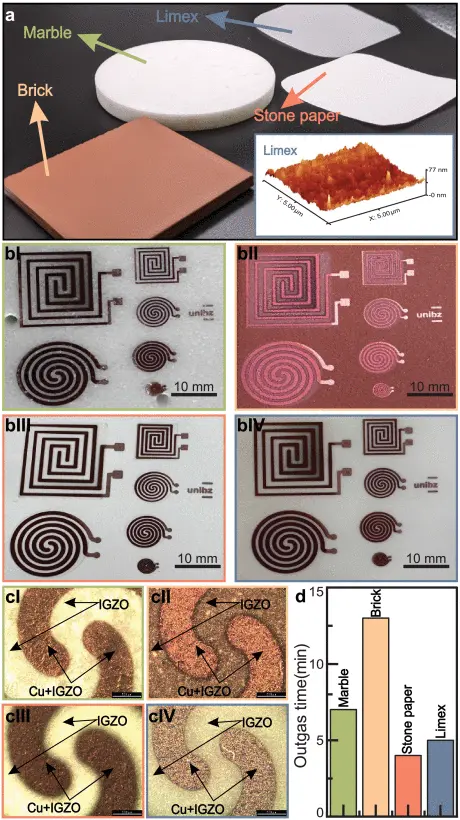Application of Stone-Derived Substrates in Thin-Film Temperature Sensing
Advancements in thin-film electronic technology have led to an increasing demand for innovative electronic devices, raising significant concerns about electronic waste. While recycling remains a challenge and is often not fully achievable, producing sustainable electronics using environmentally friendly materials has emerged as a viable solution.
Since every electronic device begins with a substrate, developing biodegradable and recyclable alternatives to conventional materials like glass and plastics is essential. Although biodegradable substrates such as paper and polymer-based materials have been explored, they often suffer from mechanical instability, limited temperature resistance, and challenges in vacuum deposition compatibility.
This study introduces stone-derived substrates as novel biodegradable alternatives for thin-film temperature sensing, aiming to demonstrate their high compatibility with vacuum deposition techniques and superior heat resistance.
Four types of stone-derived substrates were investigated: natural unprocessed marble, heat-treated brick, and two flexible commercial stone-based composites: stone paper and Limex. Stone paper is composed of calcium carbonate and non-toxic high-density polyethylene, whereas Limex consists of calcium carbonate and polypropylene. These materials were used as substrates for fabricating amorphous InGaZnO (IGZO) based thermistors and Zinc (Zn)-based resistance temperature detectors (RTDs).
The temperature sensors were successfully fabricated using the sputtering deposition technique, with each stone-based substrate showing compatibility with this vacuum technology. Two heating methodologies were applied to evaluate their electrical response. Temperature cycling was conducted using a hotplate for thermistors, with surface temperature monitored via a thermal camera. In contrast, a localized heating method from above was used to cycle the temperature of the RTDs. The performance of all temperature sensors was analyzed within a temperature range of 25°C to 80°C.
Results demonstrated that among the IGZO thermistors, marble-based thermistors exhibited the highest sensitivity during heating, highlighting marble’s high thermal conductivity and suitability for high-precision temperature sensing. The thermistors exhibited ohmic behavior and showed a decreasing resistance under increasing light intensity, which is attributed to IGZO’s light sensitivity as a semiconductor. Additionally, the mechanical flexibility of stone paper thermistors was evaluated through bending tests, showing a slight increase in resistance under tensile strain.
On the other hand, RTDs exhibited a linear temperature response, with Limex-based RTDs demonstrating the highest sensitivity during heating. Notably, stone paper and Limex RTDs exhibited minimal hysteresis, making them stable for real-time temperature monitoring. More significantly, this study demonstrated dissolvable Zn-based RTDs, which fully degraded within 36 hours in aqueous conditions, offering a novel approach to transient and biodegradable sensor applications.
The findings of this study highlight the potential of stone-derived substrates as sustainable alternatives to conventional electronic materials. Their high-temperature stability, mechanical robustness, and vacuum deposition compatibility make them promising candidates for next-generation biodegradable electronics. By integrating such materials into real-world applications, this research advances eco-friendly sensor technology and contributes to reducing electronic waste, thus driving a more sustainable, cleaner, and eco-friendly electronics industry.




